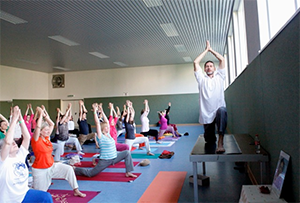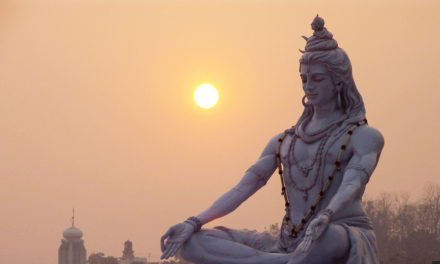 In the last article, ‘The Use of Mantras in Asana practice’, we discussed how mantra chanting has always been an integral part of yoga, even while performing asanas. In this article, we will explore the use of mantras in Pranayama, both with Amrita Yoga and in a historical context. Pranayama, also translated as “breathing exercise”, is the next limb after asana in the classical system of Ashtanga Yoga. Amma does not recommend taking up pranayama techniques without the close guidance of a yoga master. In our retreats at Amritapuri, following Amma’s advice, we are only teaching simple breathing techniques and breath awareness. In our asana classes, breath awareness and coordination of breath and movement play an important role. When we perform asanas in this way, we integrate pranayama into the asana practice. Like this, chanting MA and OM along with breath and movement can be considered a simple pranayama practice.
In the last article, ‘The Use of Mantras in Asana practice’, we discussed how mantra chanting has always been an integral part of yoga, even while performing asanas. In this article, we will explore the use of mantras in Pranayama, both with Amrita Yoga and in a historical context. Pranayama, also translated as “breathing exercise”, is the next limb after asana in the classical system of Ashtanga Yoga. Amma does not recommend taking up pranayama techniques without the close guidance of a yoga master. In our retreats at Amritapuri, following Amma’s advice, we are only teaching simple breathing techniques and breath awareness. In our asana classes, breath awareness and coordination of breath and movement play an important role. When we perform asanas in this way, we integrate pranayama into the asana practice. Like this, chanting MA and OM along with breath and movement can be considered a simple pranayama practice.
Traditional and Historical Context of Pranayama
Traditionally, pranayama was handed down from guru to disciple, and internal chanting of mantras during Kumbhaka (breath retention) was also part of the practice. Kumbhaka is added in advanced pranayama after having extended inhalations and exhalations comfortably and having gained a considerable amount of control over them. This internal chanting during Kumbhaka was done, at least in part, to keep the mind focused and absorbed in the vibration of the mantras representing a certain deity. Yoga Yajnavalkya Samitha, one of the important yoga texts also explains the importance of mantras with pranayama. The text states, “The upward breath and the downward breath, having been restrained, regulation of breath is to be practiced by means by means of the Pranava Mantra OM.”
Pranayama in its true sense means “expansion of prana.” Conventionally, this expansion is achieved mainly through seated breathing exercises where one refines the breath systematically, extending the time of inhalation, exhalation and breath retention. This is a very difficult undertaking, which not only needs special guidance, but also is very time consuming requiring a lot of patience. For most of us, this kind of intense pranyama practice is not really suitable. Instead, by simply observing the breath during the asana practice, we can improve the quality of our breath, making it smooth and full. With this kind of proper breathing our whole body will become energized. This energized feeling is, in a way, the result of a prana-expansion through good quality breathing.
What is the ultimate benefit of chanting mantras?
As a yoga practitioner we find that, at times, while performing an asana or pranayama exercise our mind wanders off even when given the breath or alignment to focus on. By training the mind to internally chant simple mantras during the practice, a positive habit is slowly being created. Even the well-known modern Yoga teacher, BKS Iyengar, in his classic Light of Yoga recommends internal japa during breath awareness saying “…this repetition of sacred words or names is the seed planted in the yogi’s mind. This seed grows and makes him fit for Dhyanam (meditation)”. After repeated efforts to stay with the mantra, the chanting slowly happens more and more effortlessly. This positive habit grows with practice into a strong pillar, to which the wandering mind can hold on and thus experience a certain amount of stillness in the asana. The vibrations of the mantras also have a soothing effect on the parasympathetic nervous system, the part of the body that allows us to relax and release tension.
But moreover, the whole aim of mantra chanting is to become one with the vibrations of these sacred sounds. The mantras are most often dedicated to a certain deity and all deities are nothing but a direct reflection of the universal consciousness. In Amrita Yoga, the mantras MA and OM are used extensively. These sounds carry the vibration of universal love and divine light which is the essence of the whole universe. Chanting these mantras not only helps us to come closer to our true nature but also leads us to the experience of oneness with the whole of creation. This realization of oneness or experience of union is ultimately the aim of all yoga.
Author: Dayalu Alwin D’Angelo


